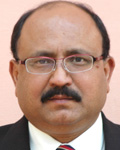
Last year, Indian Prime Minister Narendra Modi urged the UN General Assembly to observe June 21 as the International Day of Yoga. The date is also important in Hindu philosophy as it is when Lord Shiva, the first yoga practitioner, is said to have begun imparting the knowledge of yoga to the rest of mankind, thus becoming the discipline's first guru.
On June 21, India broke two world records as thousands led by Modi performed yoga at Rajpath, a ceremonial boulevard in New Delhi. It was both the world's largest-ever yoga class, with 35,985 attendees, and involved the most nationalities participating in a single yoga event--84.
On the day, yoga mats were rolled out along the banks of the River Thames in London, under the Eiffel Tower in Paris, and in New York's Times Square, where Indian Foreign Minister Sushma Swaraj was in attendance. A mass yoga session was also held at the UN headquarters--the "first in UN history," tweeted Vikas Swarup, a spokeswoman for the Indian Ministry of External Affairs. In her address, Swaraj remarked, "The word 'yoga' means 'to unite, to join'... We hope this will help bring the world together."
For years yoga has been widely practiced all over China, especially by youngsters, but this international event has no doubt given a further boost to the popularity of the discipline, with events being held in many Chinese cities, including Beijing, Shanghai and Guangzhou. In May, yoga received an official nod when Premier Li Keqiang attended a yoga-taichi meeting with Modi during his China visit.
As a physical, mental, and spiritual practice, yoga is one of India's most important contributions to world culture. Though its origins stretch back to around the sixth and fifth centuries B.C., its literal meaning is all the more relevant today.
The first use of the root of word "yoga" is in hymn 5.81.1 of the Rig Veda, written in the Vedic period, between 1700 B.C. and 500 B.C. The hymn is a dedication to rising sun god in the morning (Savitri), and in this context, it has been interpreted as meaning "yoke." The meanings of yoga range from literal to philosophical. According to Pānini, a sixth-century B.C. Sanskrit grammarian, the term could have been derived from either one of two roots, yujir yoga (to yoke) or yuj samādhau (to concentrate).
However, the first known appearance of the word "yoga" in its modern sense is in the Katha Upanishad, an Indian classic composed sometime between the fourth and third centuries B.C. Here, it is defined as the steady control of the senses, which, together with the cessation of mental activity, leads to a supreme state.
For the advanced practitioner, the discipline was held to possess a range of transcendental uses, from acting as a vehicle for entering into other bodies to generating multiple bodies and attaining other supernatural feats. These arts are described in the Tantric literature of Hinduism and Buddhism.
For the contemporary man on the street, the principal meaning of yoga varies. Yoga can constitute a disciplined method for attaining a goal, a technique for controlling body and mind, or a method to examine one's perception and cognition. The discipline gained popularity in the modern world primarily over the late 19th and early 20th centuries. Since then, it has become highly popular in the West, particularly the United States, where many school districts have incorporated the discipline into their physical education programs, despite objections that the discipline is a religious practice precluded from inclusion in state-funded activities.
Many studies have tried to determine its effectiveness as a complementary intervention for a range of conditions such as asthma and those relating to mental health and the musculoskeletal system. Yoga is used for treatment of cancer patients to help alleviate depression, insomnia, pain and fatigue, and to manage anxiety. Its potential as a treatment for schizophrenia has also been explored.
The writer is an independent New Delhi-based Indian journalist who tweets as @Kishkindha and can be reached at bhootnath004@yahoo.com
Copyedited by Eric Daly
Comments to yanwei@bjreview.com
